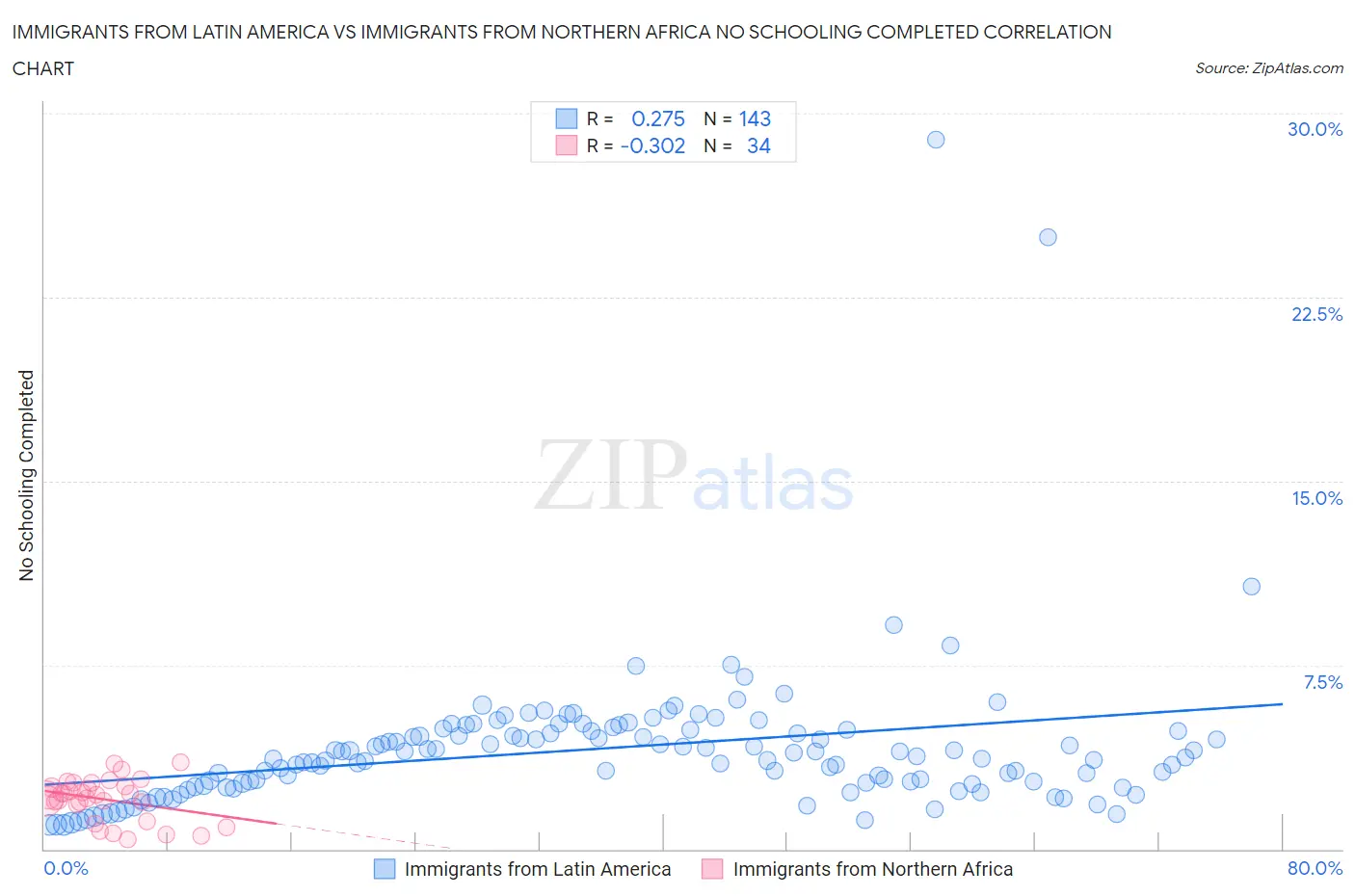Immigrants from Latin America vs Immigrants from Northern Africa No Schooling Completed
COMPARE
Immigrants from Latin America
Immigrants from Northern Africa
No Schooling Completed
No Schooling Completed Comparison
Immigrants from Latin America
Immigrants from Northern Africa
3.3%
NO SCHOOLING COMPLETED
0.0/ 100
METRIC RATING
327th/ 347
METRIC RANK
2.2%
NO SCHOOLING COMPLETED
19.5/ 100
METRIC RATING
200th/ 347
METRIC RANK
Immigrants from Latin America vs Immigrants from Northern Africa No Schooling Completed Correlation Chart
The statistical analysis conducted on geographies consisting of 544,626,329 people shows a weak positive correlation between the proportion of Immigrants from Latin America and percentage of population with no schooling in the United States with a correlation coefficient (R) of 0.275 and weighted average of 3.3%. Similarly, the statistical analysis conducted on geographies consisting of 319,330,485 people shows a mild negative correlation between the proportion of Immigrants from Northern Africa and percentage of population with no schooling in the United States with a correlation coefficient (R) of -0.302 and weighted average of 2.2%, a difference of 50.1%.

No Schooling Completed Correlation Summary
| Measurement | Immigrants from Latin America | Immigrants from Northern Africa |
| Minimum | 0.98% | 0.40% |
| Maximum | 28.9% | 3.5% |
| Range | 27.9% | 3.1% |
| Mean | 4.1% | 2.0% |
| Median | 3.7% | 2.1% |
| Interquartile 25% (IQ1) | 2.7% | 1.8% |
| Interquartile 75% (IQ3) | 4.8% | 2.6% |
| Interquartile Range (IQR) | 2.2% | 0.74% |
| Standard Deviation (Sample) | 3.2% | 0.84% |
| Standard Deviation (Population) | 3.2% | 0.83% |
Similar Demographics by No Schooling Completed
Demographics Similar to Immigrants from Latin America by No Schooling Completed
In terms of no schooling completed, the demographic groups most similar to Immigrants from Latin America are Mexican (3.3%, a difference of 0.22%), Immigrants from Vietnam (3.3%, a difference of 1.3%), Immigrants from Armenia (3.3%, a difference of 1.7%), Japanese (3.3%, a difference of 1.8%), and Indonesian (3.2%, a difference of 2.5%).
| Demographics | Rating | Rank | No Schooling Completed |
| Immigrants | Bangladesh | 0.0 /100 | #320 | Tragic 3.1% |
| Immigrants | Laos | 0.0 /100 | #321 | Tragic 3.1% |
| Immigrants | Honduras | 0.0 /100 | #322 | Tragic 3.2% |
| Vietnamese | 0.0 /100 | #323 | Tragic 3.2% |
| Mexican American Indians | 0.0 /100 | #324 | Tragic 3.2% |
| Dominicans | 0.0 /100 | #325 | Tragic 3.2% |
| Indonesians | 0.0 /100 | #326 | Tragic 3.2% |
| Immigrants | Latin America | 0.0 /100 | #327 | Tragic 3.3% |
| Mexicans | 0.0 /100 | #328 | Tragic 3.3% |
| Immigrants | Vietnam | 0.0 /100 | #329 | Tragic 3.3% |
| Immigrants | Armenia | 0.0 /100 | #330 | Tragic 3.3% |
| Japanese | 0.0 /100 | #331 | Tragic 3.3% |
| Central Americans | 0.0 /100 | #332 | Tragic 3.4% |
| Immigrants | Dominican Republic | 0.0 /100 | #333 | Tragic 3.4% |
| Guatemalans | 0.0 /100 | #334 | Tragic 3.5% |
Demographics Similar to Immigrants from Northern Africa by No Schooling Completed
In terms of no schooling completed, the demographic groups most similar to Immigrants from Northern Africa are African (2.2%, a difference of 0.46%), Costa Rican (2.2%, a difference of 0.52%), Immigrants from Chile (2.2%, a difference of 0.64%), Immigrants from Southern Europe (2.2%, a difference of 0.82%), and Immigrants from Ukraine (2.2%, a difference of 1.2%).
| Demographics | Rating | Rank | No Schooling Completed |
| Paraguayans | 29.3 /100 | #193 | Fair 2.2% |
| Immigrants | Albania | 28.3 /100 | #194 | Fair 2.2% |
| Hawaiians | 27.0 /100 | #195 | Fair 2.2% |
| Immigrants | Ukraine | 26.1 /100 | #196 | Fair 2.2% |
| Immigrants | Southern Europe | 23.8 /100 | #197 | Fair 2.2% |
| Immigrants | Chile | 22.7 /100 | #198 | Fair 2.2% |
| Africans | 21.8 /100 | #199 | Fair 2.2% |
| Immigrants | Northern Africa | 19.5 /100 | #200 | Poor 2.2% |
| Costa Ricans | 17.1 /100 | #201 | Poor 2.2% |
| Moroccans | 13.7 /100 | #202 | Poor 2.2% |
| Laotians | 13.3 /100 | #203 | Poor 2.2% |
| Hopi | 12.9 /100 | #204 | Poor 2.2% |
| Immigrants | Bahamas | 11.6 /100 | #205 | Poor 2.2% |
| Bahamians | 11.6 /100 | #206 | Poor 2.2% |
| South American Indians | 11.0 /100 | #207 | Poor 2.2% |